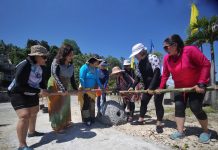The railway of Dapecol
By Antonio Figueroa
(4TH of a Series)
During the American Occupation, the railway system in Mindanao was primarily used in military camps, penal farms, and logging. At Port Lamon, in Hinatuan, Surigao del Sur, locomotives ordered from the United States transported timber from nearby forests to the pier. Inside Camp Keithley in Marawi City, the flatcars hauled war materiel using the rails.
At Davao Penal Colony, a diesel-operated locomotive pulled flatbeds that transported prisoners to work at Mactan, the penal farm’s rice fields. Raymond C. Heimbuch, in ‘5 Brothers in Arms’, (2008) described this scenario of inmates, under tight security, being delivered to their assignments using the corroded rails with rusty ties:
“A narrow gauge railroad ran from the [Davao Penal Colony] compound to approximately the center of the rice fields. The railroad equipment consisted of an old and poorly maintained diesel-powered locomotive. The rolling stock consisted of approximately thirty to forty flatbed cars. The men were loaded on this train and taken to and from the rice fields, about a forty-five minutes ride each way.”
Similarly, John D. Lukacs, in ‘Escape from Davao’ (2010), wrote that the flatcars were not only used for hauling farm manpower and harvested rice padded in sacks, these were used also in hauling logs to the nearest hauling station:
“Just beyond Mactan [rice fields], POWs hauled wet gravel in five-gallon cans from a creek bed onto flatcars. Seven miles down the rail line, others grunted and pulled in two-man teams felling mahogany behemoths with long bucksaws. The trunks of these ironlike hardwoods were so wide that when lying on their sides some were taller than the lumberjacks. The giant logs were shipped by train to the Japanese outposts at Anibongan and then floated downstream on the Tuganay River to the same sawmill whose pier the Erie Maru [ship] had tied up to.”
(Erie Maru was a steam-propelled cargo-passenger ship built in 1920, with 5493 gross tonnage. Built by the Asano Shipbuilding Co., in Tsurumi, Japan, for Ishihara Gomei-Kaisha, Fuchu, with a speed of 10.5 knots, it has the capacity to carry 2,500 passengers. It was sunk by the USS Sturgeon on Jan. 11, 1944, at Bungo Straits, 20 miles east of Saeki, Kyushu, Japan.)
American war survivor Hayes R. Bolitho, in his war account (‘The Hayes Bolitho Japanese Story’) at Dapecol, also mentioned the locomotive as an indispensable means of transport the Japanese used while they were moved from their field assignments to the incarceration camp:
“The return [of the prisoners] to the [Dapecol] compound was a gradual uphill grade and because of the rain the wheels on the locomotive were slipping. Progress was practically nil so the guards began kicking us off the car to push. They were shouting and swearing at us… Walking barefooted on slippery wood railroad ties or alongside in the weeds and brush was miserable… The train was moving slowly, but with practically no help from us. By the time we were probably a mile from camp, men in their barracks could hear singing.”
Preserving the artifacts of rails and locomotives has been a struggle for industrial archaeologists and historians. While in Negros and Dagupan two separate trains have found their appropriate places of posterity through local government help, many of the old locomotives that used to line the Tutuban train station compound in Manila have landed in junkyards.
The rails of Dapecol also met the same fate in the hands of second-hand dealers. At a time when prices of metal in the Chinese market were going through the roof, even the long-buried rails in mountainous logging hubs were dug in exchange for money.
Fast forward, today’s railway infrastructures and their uses have been redefined, especially in tourism destinations where monorails link the main entrance to the central hub. But the most significant clamor is the installation of a light railway transit (LRT) in response to the burgeoning traffic that keeps urban centers almost at a standstill by daytime.
In 2014, Davao City, confronted by a growing traffic gridlock, tapped a Korean firm to conduct a project study for a light rail transport system in the city. This long-term project is viable in addressing traffic congestion influenced in large part by the rise in vehicular population.
The proposed monorail type of LRT, with a capacity of 5,000 to 20,000 in an hour, will run at 70 kilometers per hour but also has a huge impact on the livelihood of 8,500 jeepney drivers and 14,000 tricycle drivers operating with the metropolitan streets. With Davao City projected to host around ten million people by 2040, it can become “one of the terribly trafficked cities.”





